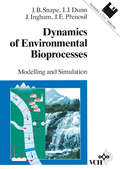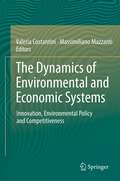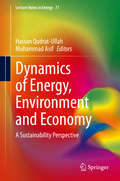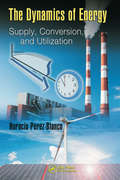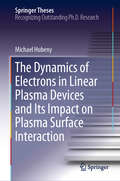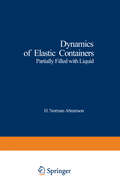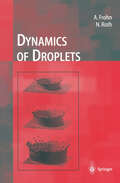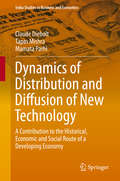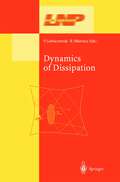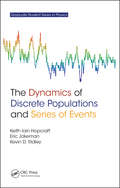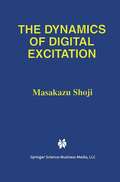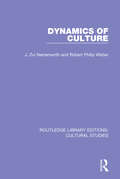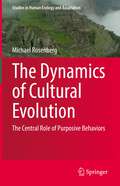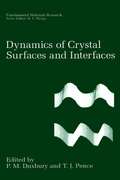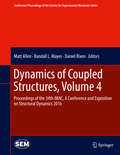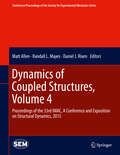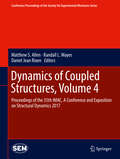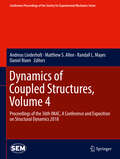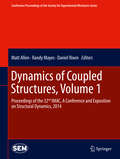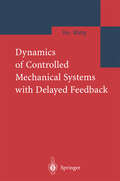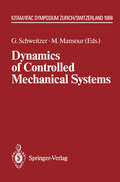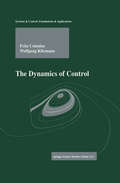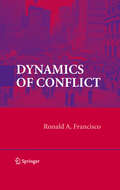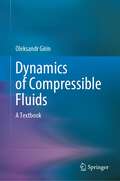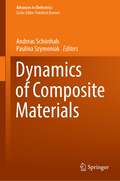- Table View
- List View
Dynamics of Environmental Bioprocesses: Modelling and Simulation
by Jonathan B. Snape Irving J. Dunn John Ingham Jiri E. PrenosilDynamic environmental processes are complex; the easiest and most effective way to understanding them lies through the disciplines of dynamic modelling and computer simulation. The prerequisite modelling fundamentals are presented in the first chapter in a manner comprehensible to students as well as to practising scientists and engineers. The second chapter describes the many environmental processes that lend themselves to modelling, for example pollution and wastewater treatment. The third part of the book provides 65 simulation examples both on the page and on an accompanying diskette in the simulation language ISIM - the first time that this has been done with a teaching book in this field - ready-to-run on any DOS personal computer. Crucially, the simulation runs can be interrupted to allow rapid interactive parameter changes and easy plotting of results; this enables the reader to get a feel for the model and system behaviour.
The Dynamics of Environmental and Economic Systems: Innovation, Environmental Policy and Competitiveness
by Valeria Costantini and Massimiliano MazzantiExploiting econometric techniques aimed at dealing with the dynamics of economic systems and the heterogeneity of agents performances, the volume integrates innovation-based reasoning with ex-post analyses, and presents ex-ante analyses able to evaluate the role of climate change policies by using computable general equilibrium models such as the Global Trade Analysis Project for Energy (GTAP-E). The authors merge and use a range of datasets, including OECD-PATSTAT and STAN, to test novel techniques informed by evolutionary economic theories and the Porter hypothesis. The immediate relevance and applicability of the models will strengthen the hand of policy analysts for whom the dynamic efficiency of environmental policy is a new, high-profile evaluation criterion.
Dynamics of Energy, Environment and Economy: A Sustainability Perspective (Lecture Notes in Energy #77)
by Hassan Qudrat-Ullah Muhammad AsifThe book addresses the vital and interwoven areas of energy, environment, and the economy within the field of sustainability research. Fundamental technical details, empirical data, and case studies taking into account local and international perspectives are included. Issues such as energy security, depleting fossil fuel reserves, global warming and climate change, as well as novel energy technologies are covered. The dynamic global response will be discussed from the perspective of policy, technology, and economics.Vital details in the form of text boxes, illustrations, graphs, tables and appendices are included. The book will serve as reference book for upper-level undergraduate and graduate students, researchers, academics, policy makers, NGOs and developmental sector professionals within the field.
The Dynamics of Energy: Supply, Conversion, and Utilization
by Horacio Perez-BlancoAs mankind searches for energy alternatives with minimal environmental consequences and acceptable cost, it is necessary to identify valid areas of endeavor that can activate favorable energy sources and technological developments. Toward that end, The Dynamics of Energy: Supply, Conversion, and Utilization develops competence in energy matters on
The Dynamics of Electrons in Linear Plasma Devices and Its Impact on Plasma Surface Interaction (Springer Theses)
by Michael HubenyTurbulence in plasma surface interaction holds crucial uncertainties for its impact on material erosion in the operation of fusion reactors. In this thesis, the design, development and operation of a Thomson scattering diagnostic and its novel implementation with fast visual imaging created a versatile tool to investigate intermittently occuring plasma oscillations. Specifically, ballistic transport events in the plasma edge, constituting turbulent transport, have been targeted in this thesis. With the help of a custom photon counting algorithm, the conditional averaging technique was applied on Thomson scattering for the first time to allow spatial and pseudo-time-resolved measurements.Since plasma turbulence and the emerging transport phenomena are comparable in most magnetized devices, the diagnostic development and the results from the linear plasma device PSI-2 are useful for an implementation of similar techniques in larger fusion experiments. Furthermore, the obtained results indicate a strong enhancement of erosion with turbulent transport and thus underline the importance of dedicated experiments investigating plasma turbulence in the framework of erosion in future fusion reactors.
Dynamics of Elastic Containers: Partially Filled with Liquid (Applied Physics and Engineering #5)
by I.M. RapoportThe motions of liquids in moving containers constitute a broad class of problems of great practical importance in many technical fields. The influence of the dynamics of the liquid on the motions of the container itself is a most interesting and complex aspect of the general subject, whether one considers only the rigid-body motions of the container or its elastic motions as well. It is most fitting therefore that this translation of Professor Rapoport's book has been undertaken so promptly following its original publication, so as to make readily available this rather detailed account of the mathematical foundations underlying the treatment of such prob lems. Since most of this vast body of analysis has been developed over the past decade by scientists in the USSR, and has therefore been largerly unavailable to those unable to read Russian, this volume will undoubtedly be of great value to many of us. H.
Dynamics of Droplets (Experimental Fluid Mechanics)
by Arnold Frohn Norbert RothThe book deals with the dynamical behaviour of single droplets and regular droplet systems. It has been written mainly for experimental researchers. After a short description of the theoretical background, the different experimental facilities and methods necessary for the investigation of single droplets are described in detail. A summary of important applications is included.
Dynamics of Distribution and Diffusion of New Technology: A Contribution to the Historical, Economic and Social Route of a Developing Economy (India Studies in Business and Economics)
by Claude Diebolt Tapas Mishra Mamata ParhiThis book presents a comprehensive study of adoption and diffusion of technology in developing countries in a historical perspective. Combining the development of growth trajectories of the Indian economy in general and its manufacturing industry in particular, the book highlights the effective marriage between qualitative and quantitative methods for a better understanding and explaining of many hidden dynamic behaviors of adoption and diffusion trend in manufacturing industry. The use of various econometric methods is aimed to equip readers to make a judgement of the current state of diffusion pattern of new technologies in India and simulate a desirable future pattern in view of the various pro-industrial growth policies.
The Dynamics of Discrete Populations and Series of Events
by Keith Iain Hopcraft Eric Jakeman Kevin D. RidleyDiscrete phenomena are an important aspect of various complex systems, acting both as underlying driving mechanisms and as manifestations of diverse behaviours. However, the characterisation of these discrete phenomena requires models that go beyond those featured in existing books. Largely concerned with mathematical models used to describe time-v
The Dynamics of Digital Excitation
by Masakazu ShojiThe electronic circuit is a proud child of twentieth century natural science. In a hundred short years it has developed to the point that it now enhances nearly every aspect of human life. Yet our basic understanding of electronic-circuit operation, electronic -circuittheory, has not made significant progress during the semiconductor industry's explosive growth from 1950s to the present. This is because the electronic circuit has never been considered to be a challenging research subject by physi cists. Linear passive circuit theory was established by the late 1940s. After the advent of the semiconductor electron devices, the interest of the technical community shifted away from circuit theory. Twenty years later, when integrated circuit technology began an explosive growth, cir cuit theory was again left behind in the shadow of rapidly progressing computer-aided design (CAD) technology. The present majority view is that electronic-circuit theory stands in a subordinate position to CAD and to device-processing technology. In 1950s and 1960s, several new semiconductor devices were invented every year, and each new device seemed to have some interesting funda mental physical mechanisms that appeared worth investigating. Com pared to attractive device physics, the problems of the semiconductor device circuit appeared less sophisticated and less attractive. Bright minds of the time drifted away from circuit theory to electron-device physics. After thirty years only one type of semiconductor device, the electron triode with several variations survived, whereas hundreds of them went into oblivion.
Dynamics of Culture (Routledge Library Editions: Cultural Studies)
by J. Zvi Namenwirth Robert Philip WeberThis book, first published in 1987, is a landmark contribution to macrosociology that extends the tradition of Sorokin, Durkheim, Marx, Weber and other founders of the discipline in new and exciting directions. Using their innovative content analysis methodology to examine American and British political documents, the authors show that the long-term dynamics of culture are subject to their own laws and are independent of the actions of 'great men' and other individual actors. This comprehensive volume brings together over two decades of the authors' research on culture indicators. Key findings include the identification of two long-term cultural cycles in the United States and Great Britain: one is related to party realignments, the other to long-term economic fluctuations. In addition, the authors demonstrate how culture provides the themes that political parties use to interpret economic conditions in their appeal for votes. Other results show that organizational cultures move in opposite directions from those in the culture of the larger society. The book also includes detailed discussions of both the methodology used to analyse text content and related metatheoretical issues in the study of cultural dynamics.
The Dynamics of Cultural Evolution: The Central Role of Purposive Behaviors (Studies in Human Ecology and Adaptation #12)
by Michael RosenbergThis book explores the nature of cultural and culturally structured social and behavioral entities, their evolutionary interactions, and the central role purposive behaviors play in those interactions. It, first, makes the case for cultural and cultural structured systems being considered as true entities bounded in time and space, and not ephemera in a constant state of becoming another system. Second, it examines how these entities interact to produce evolutionary culture change. It then argues that the intent of purposive behaviors is reliably knowable in the aggregate, at least when dealing with expressions of behavioral tendencies in the animal kingdom, humans included. Finally, the book references well documented behavioral tendencies for examples of proximate causation in the evolution of settled village societies and, following that, socially complex societies. Through these efforts, the book synthesizes the various approaches to the evolution of culture and provides a complete and comprehensive picture of the process. It provides a corrective to the tendency to view cultural systems as entirely open ended and as capable of changing in any direction; and also to treating cultural evolution as solely a result of selective forces, that is, in terms of only ultimate causation. This book provides an engaging and critical counterview to established theories of cultural evolution and is of interest to scholars and students of different disciplines, from anthropology and archeology, to evolutionary biology and epigenetics.
Dynamics of Crystal Surfaces and Interfaces (Fundamental Materials Research)
by P. M. Duxbury T. J. PenceThis series of books, which is published at the rate of about one per year, addresses fundamental problems in materials science. The contents cover a broad range of topics from small clusters of atoms to engineering materials and involve chemistry, physics, and engineering, with length scales ranging from Ångstroms up to millimeters. The emphasis is on basic science rather than on applications. Each book focuses on a single area of current interest and brings together leading experts to give an up-to-date discussion of their work and the work of others. Each article contains enough references that the interested reader can access the relevant literature. Thanks are given to the Center for Fundamental Materials Research at Michigan State University for supporting this series. M. F. Thorpe, Series Editor E-mail: thorpe@pa. msu. edu v PREFACE th th During the period 4 -8 August 1996, a conference with the same title as this book was held in Traverse City, Michigan. That conference was organized as a sequel to an interesting and successful WEM workshop in a similar area run by Profs. Hans Bonzel and Bill Mullins in May 1995. This book contains papers presented at the Traverse City conference. The book focuses on: atomic processes, step structure and dynamics; and their effect on surface and interface structures and on the relaxation kinetics of larger leng- scale nonequilibrium morphologies.
Dynamics of Coupled Structures, Volume 4: Proceedings of the 34th IMAC, A Conference and Exposition on Structural Dynamics 2016 (Conference Proceedings of the Society for Experimental Mechanics Series)
by Matt Allen Randall L. Mayes Daniel RixenDynamics of Coupled Structures, Volume 4. Proceedings of the 34th IMAC, A Conference and Exposition on Dynamics of Multiphysical Systems: From Active Materials to Vibroacoustics, 2016, the fourth volume of ten from the Conference brings together contributions to this important area of research and engineering. Th e collection presents early findings and case studies on fundamental and applied aspects of Structural Dynamics, including papers on:• Experimental Dynamic Substructuring• Structural Coupling of Nonlinear Structures• Analytical/Numerical Modeling of Joints• Industrial Applications of Substructuring• Source Identifi cation & Transfer Path Analysis• Human Induced Vibrations• Damping & Friction
Dynamics of Coupled Structures, Volume 4: Proceedings of the 33rd IMAC, A Conference and Exposition on Structural Dynamics, 2015 (Conference Proceedings of the Society for Experimental Mechanics Series)
by Matt Allen Randall L. Mayes Daniel J. RixenDynamics of Coupled Structures, Volume 4. Proceedings of the 33rd IMAC, A Conference and Exposition on Balancing Simulation and Testing, 2015, the fourth volume of ten from the Conference brings together contributions to this important area of research and engineering. The collection presents early findings and case studies on fundamental and applied aspects of Structural Dynamics, including papers on: Substructuring and the Ampair Wind Turbine Test BedExperimental Dynamic SubstructuringReduced Order Models Experimental Studies of Joints and Joined StructuresAnalytical/Numerical Modeling of JointsIndustrial Applications of Substructuring
Dynamics of Coupled Structures, Volume 4: Proceedings of the 35th IMAC, A Conference and Exposition on Structural Dynamics 2017 (Conference Proceedings of the Society for Experimental Mechanics Series)
by Matthew S. Allen Randall L. Mayes Daniel Jean RixenDynamics of Coupled Structures, Volume 4: Proceedings of the 35th IMAC, A Conference and Exposition on Structural Dynamics, 2017, the fourth volume of ten from the Conference brings together contributions to this important area of research and engineering. The collection presents early findings and case studies on fundamental and applied aspects of the Dynamics of Coupled Structures, including papers on: Experimental Nonlinear Dynamics Joints, Friction & Damping Nonlinear Substructuring Transfer Path Analysis and Source Characterization Analytical Substructuring & Numerical Reduction Techniques Real Time Substructuring Assembling & Decoupling Substructures & Boundary Conditions
Dynamics of Coupled Structures, Volume 4: Proceedings of the 36th IMAC, A Conference and Exposition on Structural Dynamics 2018 (Conference Proceedings of the Society for Experimental Mechanics Series)
by Andreas Linderholt Matthew S. Allen Randall L. Mayes Daniel RixenDynamics of Coupled Structures, Volume 4: Proceedings of the 36th IMAC, A Conference and Exposition on Structural Dynamics, 2018, the fourth volume of nine from the Conference brings together contributions to this important area of research and engineering. The collection presents early findings and case studies on fundamental and applied aspects of the Dynamics of Coupled Structures, including papers on: Experimental Nonlinear DynamicsJoints, Friction & DampingNonlinear SubstructuringTransfer Path Analysis and Source CharacterizationAnalytical Substructuring & Numerical Reduction TechniquesReal Time SubstructuringAssembling & Decoupling Substructures & Boundary Conditions
Dynamics of Coupled Structures, Volume 1: Proceedings of the 32nd IMAC, A Conference and Exposition on Structural Dynamics, 2014 (Conference Proceedings of the Society for Experimental Mechanics Series)
by Matt Allen Randy Mayes Daniel RixenThis first volume of eight from the IMAC-XXXII Conference, brings together contributions to this important area of research and engineering. The collection presents early findings and case studies on fundamental and applied aspects of Structural Dynamics, including papers on:Linear SystemsSubstructure ModellingAdaptive StructuresExperimental TechniquesAnalytical MethodsDamage DetectionDamping of Materials & MembersModal Parameter IdentificationModal Testing MethodsSystem IdentificationActive ControlModal Parameter EstimationProcessing Modal Data
Dynamics of Controlled Mechanical Systems with Delayed Feedback
by H.Y. Hu Z.H. WangRecent years have witnessed a rapid development of active control of various mechanical systems. With increasingly strict requirements for control speed and system performance, the unavoidable time delays in both controllers and actuators have become a serious problem. For instance, all digital controllers, analogue anti aliasing and reconstruction filters exhibit a certain time delay during operation, and the hydraulic actuators and human being interaction usually show even more significant time delays. These time delays, albeit very short in most cases, often deteriorate the control performance or even cause the instability of the system, be cause the actuators may feed energy at the moment when the system does not need it. Thus, the effect of time delays on the system performance has drawn much at tention in the design of robots, active vehicle suspensions, active tendons for tall buildings, as well as the controlled vibro-impact systems. On the other hand, the properly designed delay control may improve the performance of dynamic sys tems. For instance, the delayed state feedback has found its applications to the design of dynamic absorbers, the linearization of nonlinear systems, the control of chaotic oscillators, etc. Most controlled mechanical systems with time delays can be modeled as the dynamic systems described by a set of ordinary differential equations with time delays.
Dynamics of Controlled Mechanical Systems: IUTAM/IFAC Symposium, Zurich, Switzerland, May 30–June 3, 1988 (IUTAM Symposia)
by Gerhard Schweitzer M. MansourMany mechanical systems are actively controlled in order to improve their dynamic performance. Examples are elastic satellites, active vehicle suspension systems, robots, magnetic bearings, automatic machine tools. Problems that are typical for mechanical systems arise in the following areas: - Modeling the mechanical system in such a way that the model is suitable for control design - Designing multivariable controls to be robust with respect to parameter variations and uncertainties in system order of elastic structures - Fast real-time signal processing - Generating high dynamic control forces and providing the necessary control power - Reliability and safety concepts, taking into account the growing role of software within the system The objective of the Symposium has been to present methods that contribute to the solutions of such problems. Typical examples are demonstrating the state of the art It intends to evalua~ the limits of performance that can be achieved by controlling the dynamics, and it should point to gaps in present research and areas for future research. Mainly, it has brought together leading experts from quite different areas presenting their points of view. The International Union of Theoretical and Applied Mechanics (lUTAM) has initiated and sponsored, in cooperation with the International Federation of Automatic Control (IF AC), this Symposium on Dynamics of Controlled Mechanical Systems, held at the Swiss Federal Institute of Technology (ETH) in Zurich, Switzerland, May 3D-June 3, 1988.
The Dynamics of Control (Systems & Control: Foundations & Applications)
by Fritz Colonius Wolfgang KliemannThis new text/reference is an excellent resource for the foundations and applications of control theory and nonlinear dynamics. All graduates, practitioners, and professionals in control theory, dynamical systems, perturbation theory, engineering, physics and nonlinear dynamics will find the book a rich source of ideas, methods and applications. With its careful use of examples and detailed development, it is suitable for use as a self-study/reference guide for all scientists and engineers.
Dynamics of Conflict
by Ronald A. FranciscoThe mechanisms of protest and revolution have been the subject of theoretical research for over a century, yet the lack of data has hindered the empirical validation of conflicting theories. In this book, the author presents a unique new set of sub-daily data from over thirty countries and seven civil wars and uses them to test two models of conflict, the predator-prey model and the competing species model. The dynamic nature of the data modelling and the novelty of the dataset make this work a unique contribution to the field of conflict research. Dynamics of Conflict will help to re-evaluate existing theories and chart a new course towards the formal and statistical modelling of conflict.
Dynamics of Compressible Fluids: A Textbook
by Oleksandr GirinCompressibility is a property inherent in any material, but it does not always manifest itself. Experience suggests that it affects the medium motion only at velocities comparable to the speed of sound. Why do we study compressibility? It turns out that in order to calculate the aircraft streamlining or the internal flow in its engine, or the shell muzzle velocity, or the dynamic load of a shock wave from an accidental blast on a structural element, and in many other cases it is necessary to know and understand the laws of the Dynamics of Compressible Media (DCM) and be able to apply them in practice. This textbook is designed to help readers achieve this goal and learn the basics of DCM. This field of knowledge is high-tech and always focuses on the future: modern developments of hypersonic aircraft, designing more advanced structural elements for airplanes and helicopters, calculating the car aerodynamics, etc. Paradoxes have always given impetus to the search for new technological devices. Unusual effects in DCM include the flow chocking in supersonic outflow from reservoirs (Sect.2.2); the shock wave formation inside an initially smooth flow (Sect.5.3); the generation of a "spallation saucer" of armor inside a tank when a shell hits it (Sect.5.5); the dog-leg of a plane discontinuity surface at shockwave reflection from a rigid wall (Sec.8.1). The way to understand these and other effects is through the creation of quantitative models of a moving compressible fluid.
Dynamics of Composite Materials (Advances in Dielectrics)
by Andreas Schönhals Paulina SzymoniakThe book presents recent developments in the field of composites, investigated by Broadband Dielectric Spectroscopy (BDS) and sheds a special focus on nanocomposites. This volume compares the results obtained by BDS with data from other methods like hyphenated calorimetry, dynamical-mechanical spectroscopy, NMR spectroscopy and neutron scattering. The addressed systems range from all kinds of model systems, such as polymers filled with spherical silica particles, advanced materials such as polymers with molecular stickers or hyperbranched polymer-based matrices to industrially significant systems, like epoxy-based materials. The book offers an excellent insight to a valuable application of dielectric spectroscopy and it is a helpful guide for every scientist who wants to study dynamics in composite materials.
